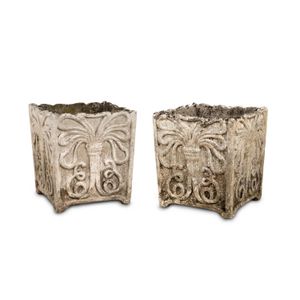19th Century English Terracotta Garland Plaques Pair
You must be a subscriber, and be logged in to view price and dealer details.
Subscribe Now to view actual auction price for this item
When you subscribe, you have the option of setting the currency in which to display prices to $Au, $US, $NZ or Stg.
- Terracotta - Terracotta is lightly fired earthenware, red or reddish-brown in colour, used in ancient times. Fired at higher temperatures terracotta was used in the nineteenth century for decorative vases and similar objects, but rarely for utilitarian goods. Other uses for terracotta include roofing tiles, garden pots and ornaments. Glazed terracotta is known as faience.
- Floral Swag / Garland / Festoon - Floral swags are a decorative motif often used in the ornamentation of various objects, such as silverware, glassware, and furniture. The term "swag" refers to a garland or wreath of flowers, foliage, or other decorative elements, which is usually arranged in a loop or curve.
Floral swags can be found in a variety of decorative styles, from ornate Baroque and Rococo designs to more naturalistic Art Nouveau and Art Deco styles. They are often used to add a touch of elegance, refinement, or whimsy to an object, and can be seen on a range of items from chandeliers and candlesticks to picture frames and tea sets.
In the decoration of silver objects, floral swags are often used to accentuate the curves and lines of the piece, and to add visual interest to the surface. Similarly, on glass objects, floral swags may be used to frame or highlight a particular area of the object, or to add a touch of color and delicacy.
On furniture, floral swags can be found on a variety of pieces, from cabinets and armoires to chairs and sofas. They are often used to enhance the lines and curves of the furniture, and can be used to create a sense of movement and flow in the design.
Overall, floral swags are a versatile decorative element that can be adapted to a range of styles and applications, and have been used in the decoration of various objects throughout history.
This item has been included into following indexes:
Visually similar items

A pair of foliate patterned square jardinieres, French circa 1900, 41 cm high, 36 cm square

English hallmarked sterling silver Victorian bottle holder & vase holder both decorated with birds amongst foliage. The bottle holder is pierced & sits upon four feet. London, 1898, maker William Comyns & Sons. Height 5.8 cm. Weight 78g the vase holder. Lo

Naive cedar pokerwork tray showing Australian coat of arms; and two other piece of naive woodwork, tray 52 x 34 cm (3)

A Louis XV giltwood marble topped console table, French, 18th century. 88 cm high, 182 cm wide, 50 cm deep
